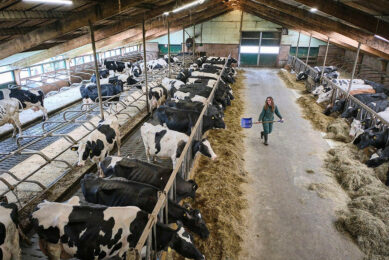Extra two litres of milk with balanced diet

Dairy farmers could boost the output from their cows by as much as two litres per day by increasing the energy density of their diets, says Dr Donald Lawson, of animal feed supplement specialists, Ufac (UK) Ltd.
He points out that many types of forage are of poor quality and have lower energy density values this season and, with first-cut silages in short supply, second or even third cuts are now being fed to dairy cows, which has further reduced the average energy value of forage being fed.Target values for freshly-calved cows, should be 12.0-12.5 MJ/kg DM to maintain milk yield, good body condition and fertility.
"Adding more concentrates is generally seen as the simplest way to increase energy density when forage ME levels are low, but it’s important not to reduce forage below a safe level of 45-50 per cent on a dry matter basis," said Dr Lawson. "As an example, if the dry matter intake is 22 kg, then forage should be at a minimum of 9.9 kg DM or 49.5 kg fresh weight if silage has a dry matter of 20 per cent. If we go below the safe level then rumen function will be compromised and acidosis may result," he warned.
It is important, he says, to ensure that the concentrate portion of the diet has a high enough energy level to meet the energy density demands within the constraints of the safe forage level. This can be achieved by using a concentrated energy supplement, such as Ufac’s Dynalac. Formulated from a special blend of oils, it has a slow release system to ensure that the oil safely reaches the rumen and small intestine.
Depending on the diet it should be added at 0.36 to 0.70 kg to achieve the target energy density. For example, with an average forage ME of 10.8 from a combination of first-cut and second-cut silage, and wholecrop wheat, and a concentrate portion with an ME of 13.0 it should be fed at the rate of 0.45 kg per cow per day to give an energy density of 12.25 MJ.
"We have already seen responses of 1.5-2.0 litres per day from increasing energy density this winter. With milk quotas no longer restricting production this provides useful prospect of increasing boosting returns over the winter period," he said. Dr Lawson has calculated that, with milk sold at 25 p per litre, allowing for the cost of the product and the materials it replaces, the extra 2 litres production of milk per day could increase returns per month by £10.70 (€11.90) per cow or £2,140 (€2,379) per month for a 200-cow herd for the remainder of the winter.
Related news:
Happy cows produce more milk











